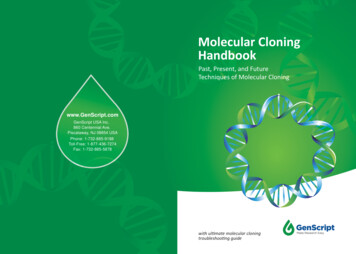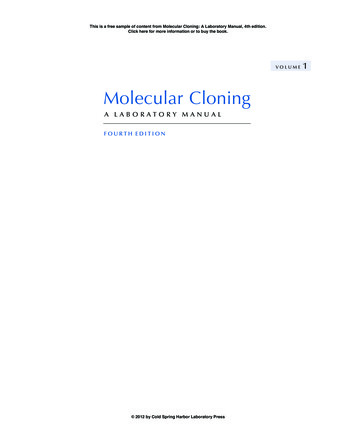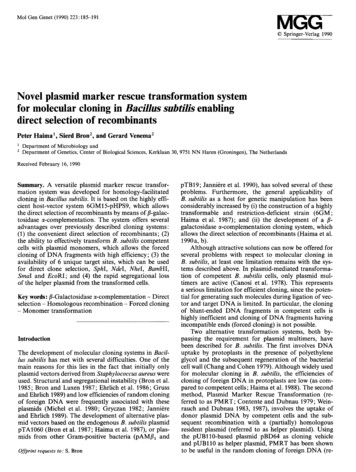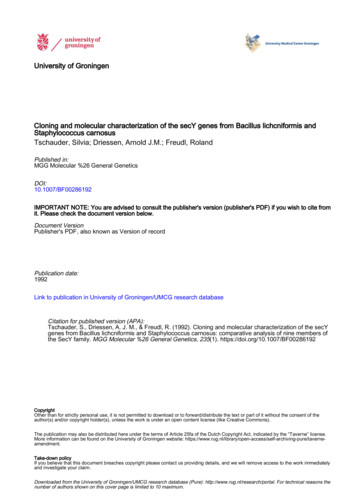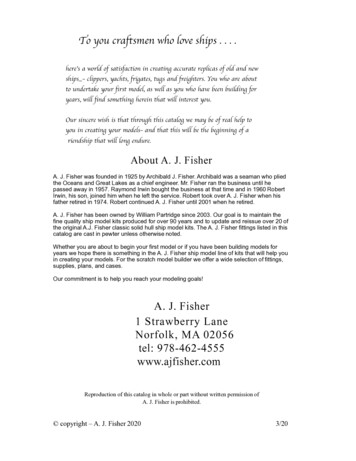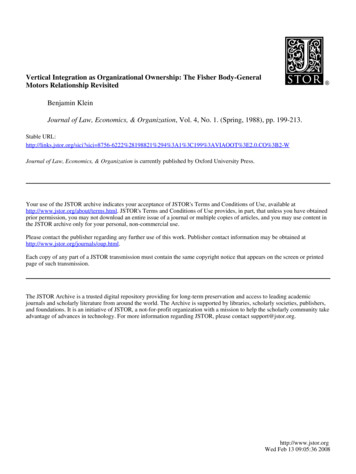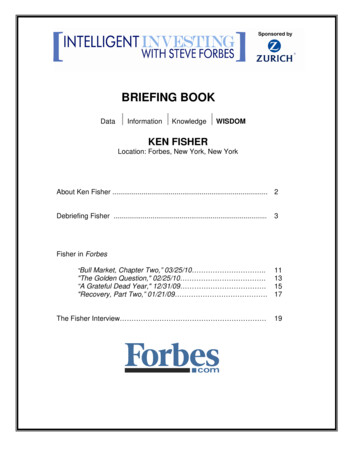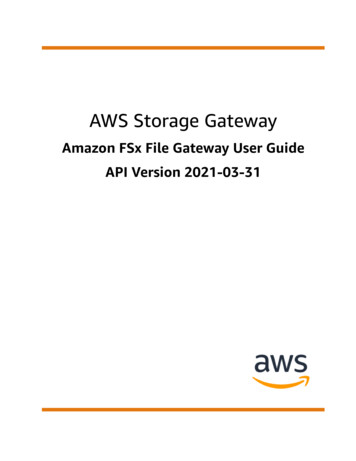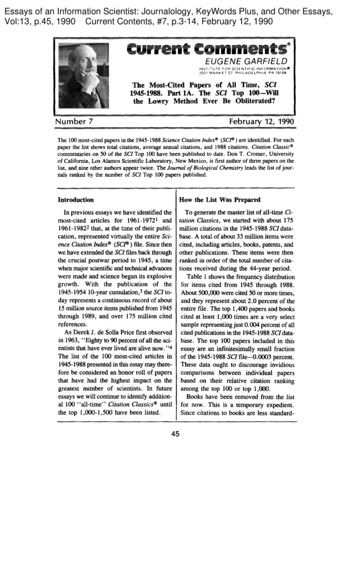
Transcription
Gateway cloning technologyThe easy-to-use choice for cloning in multipleexpression systems
The trusted leader in cloningtechnologyInvitrogen Gateway cloning technology has been citedby life science researchers more than 2,000 times. It’sno wonder Gateway cloning has been the go-to choicefor years, by researchers with varying experience—frombeginners to advanced—for protein expression, functionalanalysis, and much more.Circumvent the roadblocks of traditional restriction enzymecloning—no need for ligase, subcloning steps, or the hoursspent to screen countless colonies. Experience Gatewaycloning technology. Fast reactions—1-hour room temperaturecloning reactions Accurate results—cloning reactions achieve 95%efficiency to deliver the clone you need Versatile technology—easily shuttle DNA material/insertfrom vector to vector Streamlined protocol—no need for resequencing; usethe same clone from target identification to validation
ContentsBasic cloning methodology4Product selection guide6 MultiSite Gateway Pro technology10Ordering information12
Basic cloning methodology:three steps to better efficiencyEntry clones, Clonase enzymes, and Destination vectorsDetermine the Entry cloneThe Entry clone is how and where you start your experiment,as it contains your gene of interest or DNA fragment flankedby attL sequences, which are then used to recombine withattR sequences to create your desired expression clone.Choose one of our Invitrogen TOPO cloning vectors tocreate your Entry clone, or purchase a premade clone fromour validated Invitrogen Ultimate ORF Clone Collection.Mediate the reaction with Clonase enzymesOnce the Entry clone is ready, the gene of interest is easilyshuttled to a secondary plasmid, the Destination vector. Thisreaction is mediated by Invitrogen LR Clonase enzyme mix,which contains the protein machinery necessary to excisethe gene of interest from the Entry clone and integrate it intothe Destination vector, which then becomes your expressionclone. Reversing this reaction is simple: it requires a BPreaction (recombination between attB and attP sites) usingInvitrogen BP Clonase enzyme mix.Both LR Clonase and BP Clonase enzyme mixes aresupplied in easy-to-use master mix formats, ensuringconsistency and reliability from reaction to reaction.4Select the Destination vectorOnce you have cloned your gene of interest or DNA fragmentinto a Gateway vector, you can shuttle it to as manyexpression and functional analysis systems as you need.The diverse selection of expression vectors available withGateway cloning technology is vast and broad. Fromexpression proteins in E. coli, yeast, insect, or mammaliancells to RNAi studies, from crystallography to protein–proteininteraction functional studies, there is a Destination vectorfor your application. And for those applications that require aspecialized or customized vector, the Invitrogen Gateway Vector Conversion System can convert any vector into onecompatible for Gateway cloning.
DNA fragments from:Polymerasechain reactionRestrictionendonucleasedigestion and ligationcDNA library orclone collectionE. coligeneYeastgeneGeneArt Strings DNAFragments or LibrariesYour vectorgeneEntry re 1. Gateway technology facilitates cloning of genes into and backout of multiple vectors via site-specific recombination. Once a gene iscloned into an Entry clone, you can then move the DNA fragment into one ormore Destination vectors simultaneously.5
Product selection guideLearn which products to implement at each stageCreating an Entry cloneUsing TOPO vectors or PCR amplification/restriction-enzymevectors is the most common way to construct your ownEntry clone.TOPO vectors—both options offer 5-minute cloning and 95% efficiencypCR8/GW/TOPO Cloning KitspENTR/D-TOPO Vectors Convenient sequencing Fast Directional TOPO cloning Robust selection in E. coli with spectinomycin resistance Delivers insert in correct orientation Easy excision of insert DNA with flanking EcoRI sites Contains necessary attL sequences for recombinationinto any Destination vector Select versions carry a TEV protease cleavage site forproducing native proteins after expressionpENTR/TEV/D-TOPOTCC TTAGG AAG TGGAAG GGTTTC CCAAscINotITOPOTEVTOPOpENTR/SD/D-TOPOgene 10 RBSAAG GGTTTC CCAAscINotITOPOCCC TTGGG AAG TGGTOPOpENTR/D-TOPOCCC TTGGG AAG TGGC oripUattL1AAG GGTTTC CCATOPOattL2pENTR2.6 kbRKa n6AscINotITOPOFigure 2. Several Invitrogen pENTR vectors are availablefor directional TOPO cloningand direct access to themultitude of Gateway expression vectors.
Purchasing a premade cloneYou can also utilize Gateway technology with a ready-touse clone from our extensive clone collection. The UltimateORF Clone Collection consists of high-quality, full-insert–sequenced human and mouse open reading framesalready cloned into the Invitrogen pENTR 221 vector forlimitless downstream analysis capabilities. Clones containDNA- and amino acid sequence–verified, expression-readycDNAs for kinases, G-protein–coupled receptors (GPCRs),phosphatases, ion channels, chemokines, nuclear receptors,and cytokines.View the Ultimate ORF Clone Collection atthermofisher.com/orfPCR amplification or restriction-enzyme cloning vectorspDONR and pENTR VectorsThese vectors allow you to clone a PCR product amplified with primers containing attB sequences (Invitrogen pDONR vector) or specific restriction sites (Invitrogen pENTR vector). Using PCR to generate the Entry clone, two short artificialattB sequences (attB1 and attB2) must flank your gene of interest and be added to specific primers that are used toamplify the gene of choice. The DNA fragment is combined with a donor vector that contains attP1 and attP2 sequencesand with BP Clonase II enzyme. 90% of the colonies contain the Entry clone with the gene of interest in the correct orientation Final Entry clones are ready for recombination with any Invitrogen Gateway Destination vectorP1AccdBP2Donor vector B1B2attB DNA fragmentBP Clonase IIL1L2Entry cloneBL1CLigaseTOPOTOPOL2TOPO-adaptedentry vectorL1L2Digestedentry vector DNA fragment DigestedDNA fragmentFigure 3. Strategies to build the Entry clone. The three possible methods that lead to the Entry clone are depicted:(A) BP cloning, (B) TOPO cloning, and (C) restriction enzyme and ligase cloning. Red arrows represent the fragment ofinterest. Adapted from Katzen F (2007) Expert Opin Drug Discov 2(4):571–589.7
Clonase enzyme mix selection guideBP Clonase II Enzyme MixLR Clonase II Plus Enzyme MixApplicationCreating Entry clonesCreating expression clonesProteins involved insite-specific recombination Int (integrase) Int (integrase) IHF (integration host factor) IHF (integration host factor) Xis (excisionase)ActivityAdvantages DNA recombinase DNA recombinase DNA-binding protein DNA-binding protein High efficiency for Entryclone construction Highest cloning efficiency for singleand multiple-fragment cloning Single-mix format eliminates pipettingsteps and hands-on errors Optimized for difficult cloning reactions Easy-to-use, single-mix format ensuresenzyme stability Easy-to-use, single-mix format ensuresenzyme stability Convenient 10 µL reaction setup Convenient 10 µL reaction setup Works with MultiSite GatewayPro technologyccdBattL1attL2 attR1Entryclone ccdBattR2LR ttP1 attP2DonorvectorBP clonaseKanRAmpRAmpRKanRFigure 4. The Gateway reactions. The scheme shows the four types of plasmids and enzyme mixes involved in Gateway cloningreactions. Red arrows represent the fragment of interest. Adapted from Katzen F (2007) Expert Opin Drug Discov 2(4):571–589.8
Destination vector selection guideGateway cloning technology is especially noted for its utility in protein expression. The flexibility and diverse selection ofDestination vectors and host systems is particularly attractive for multidisciplinary protein expression studies.Destination vectors for protein expressionHost system for protein expressionE. coliGateway Destination vector family pDEST 14, 15, 17, and 24 pET160 and pET161 DEST vectorsYeastpYES2-DEST52Insect cellsBaculoDirect C-Term Expression KitMammalian cells (constitutive expression)pcDNA Mammalian Expression vector familyMammalian cells (regulated expression)pT-REx-DEST30 and pT-REx-DEST31 vectorsMammalian cells (viral delivery)ViraPower Lentiviral Expression SystemsDestination vectors for additional application areasApplicationGateway Destination vector familyAntibody or antigen productionChampion pET Expression systemsLocalizationVivid Colors pcDNA GFP Destination vector familyProtein arrayExpressway Plus Expression SystemProtein–protein interaction studiesProQuest Two-Hybrid System using Gateway technologyReporter assayGeneBLAzer pcDNA vector familyRNAiGeneBLAzer pcDNA vector family9
MultiSite Gateway Pro technologyMix and match fragments while maintaining orientationMultiSite Gateway Pro KitsWhat if you could easily and accurately assemble multipleDNA fragments in the order and orientation of your desire?This approach, called Invitrogen MultiSite Gateway Protechnology, allows the mixing and matching of functionalfragments in a concerted fashion to generate multi-segmentconstructs. MultiSite Gateway Pro technology enables youto perform pathway reconstitution, multiple gene expressionand regulation, protein interaction studies, and more.This approach has several applications covering theengineering of proteins, pathways, and cells, and provides ahighly flexible platform for functional analysis.The full power of Gateway cloning is realized withMultiSite Gateway Pro technology, which allows for thesimultaneous assembly of multiple fragments into a singlevector in a predefined order, orientation, and reading frame(Figures 5 and 6).2 fragments1. PCR-amplify your DNAelements of interest with specificattB-containing PCR primers.2. Generate Entry clones throughGateway BP recombination withattB-flanked PCR fragments and theappropriate pDONR vectors.B1B5rB5 3. Recombine entry clones with aGateway Destination vector (withattR1 and attR2 sites) to generate anexpression plasmid.Figure 5. How MultiSite Gateway Pro technology works.103 fragmentsB2B1B4B4r B3r 4 fragmentsB3B2B1B5rB5 B4B4r B3r B3B2
CMVB1YFPB2pCMVB1YFPB2pCMVB1YFPB2B1 pCMVpCMVB1B5YFPYFPB2B2B1 pCMV B5YFPB2B1 pCMV B5YFPCFP filterGFP/YFP filterB2EF-1αpromoterB1 pCMV B5YFPB2pCMV B1YFPB4 EF-1α B3CFPB2B1 pCMV B5YFPB2promoterDpCMV B1YFPB4 EF-1α B3CFPB2promoterpCMV B1YFPB4 EF-1α B3CFPB2promoterEF-1αEF-1αpCMV B1YFPB4 promoterB3CFPB2EpromoterEF-1αB1 pCMVYFPpCMVB1B5YFPB4B4promoterB3 B3 CFPCFP B2 B2EF-1αB1 pCMV B5YFPB4B3CFPB2promoterB1 pCMV B5YFPB4 EF-1α B3CFPB2promoterFigure 6. An example of using MultiSite GatewayPro technology to study expression of multiple genes in human cells. Entry clonesEF-1αcontainingCFP and theB4CMV and EF-1αinto the Invitrogen pcDNA 6.2/V5-PL-DEST VectorB1 genespCMVforB5YFP andYFPB3 promotersCFP were recombinedB2 promoter(A, C, and E) or into the Invitrogen pcDNA 6.2/V5-DEST Vector (B and D). The resulting expression clones were used to transfect HeLa cells. B1 pCMVB5 underYFPB4 microscope.B3 The InvitrogenCFPB2 6.2/V5-PL-DEST Vector is a promoterless derivative of theExpressionwas verifieda fluorescencepcDNAInvitrogen pcDNA 6.2/V5-DEST Vector, which carries the CMV promoter.11
Ordering informationTOPO TA cloningProductDescriptionQuantityCat. No.pCR8/GW/TOPO TACloning KitEfficient TOPO TA cloning kit simplifies Entryclone construction20 reactionsK250020pCR8/GW/TOPO TACloning KitEfficient TOPO TA cloning with fast-growing competentE. coli that shortens the time for Entry clone construction20 reactionsK252020pCR8/GW/TOPO TACloning KitEfficient TOPO TA cloning with fast-growing competentE. coli and plasmid purification drastically shortens and20 reactionssimplifies Entry clone construction, saving time and hassleK252002ProductDescriptionQuantityCat. No.pENTR/D-TOPOCloning KitDirectional TOPO cloning kit that produces expressionready Entry clones20 reactionsK240020pENTR/SD/D-TOPOCloning KitDirectional TOPO cloning kit, including the Shine-Dalgarnosequence that creates an E. coli expression–ready20 reactionsEntry cloneK242020pENTR/TEV/D-TOPOCloning KitDirectional TOPO cloning kit that creates expression-readyEntry clones with 5 TEV sequence for N-terminal tag20 reactionsremoval (creating native proteins)K252520pENTR/TEV/D-TOPOCloning KitDirectional TOPO cloning kit with fast-growingcompetent E. coli that shortens the time for Entry cloneconstruction while creating expression-ready Entryclones with a 5 TEV sequence for N-terminal tag removal(creating native proteins)20 reactionsK253520Directional TOPO cloningPCR cloning using BP recombinationProductDescriptionQuantityCat. No.PCR Cloning System withGateway technologyComplete kit for directional cloning into a Gateway vectorwith pDONR 221 vector with kanamycin selection20 reactions12535029PCR Cloning System withGateway technologyComplete kit for directional cloning into a Gateway vectorwith pDONR/Zeo vector with Zeocin antibiotic selection20 reactions12535037pDONR 221 VectorContains a pUC origin for high plasmid yields anduniversal M13 sequencing sites for ease of use6 μg12536017pDONR Zeo VectorContains a pUC origin for high plasmid yields anduniversal M13 sequencing sites for ease of use. Alsosupplied with 1.25 mL Zeocin Selection Reagent6 μg1253503512
Ordering informationRestriction enzyme cloningProductDescriptionQuantityCat. No.pENTR 1A VectorRestriction enzyme cloning vector that produces in-frame(rf 0), expression-ready Entry clones, including bothShine-Dalgarno and Kozak sequences10 μg11813011pENTR 2B VectorRestriction enzyme cloning vector that produces in-frame(rf 1), expression-ready Entry clones10 μg11816014pENTR 3C VectorRestriction enzyme cloning vector that produces in-frame(rf 2), expression-ready Entry clones10 μg11817012pENTR 4 VectorSame as pENTR 1A Vector except with NcoI instead ofDraI in MCS that produces in-frame (rf 0), expressionready Entry clones10 μg11818010pENTR 11 VectorSame as pENTR 1A Vector except with NspV instead ofDraI in MCS that produces in-frame (rf 0), expressionready Entry clones10 μg11819018Multifragment assembly with Gateway technologyProductDescriptionQuantityCat. No.MultiSite Gateway ProPlus KitAllows for flexible cloning of up to four fragments into aGateway Destination vector20 reactions12537100pcDNA 6.2/V5 PL-DESTVectorA promoterless version of our most popular pcDNA vectorfor use with any of the MultiSite Gateway Pro Kits. Vector 6 μghas C-terminal V5 and blasticidin selection1253716213
Ordering informationUltimate ORF ClonesProductUltimate Human ORF CloneUltimate Mouse ORF CloneDescriptionCat. No.The Ultimate ORF Clone Collection contains DNA- and aminoacid sequence–verified and expression-ready cDNAs for kinases,G-protein–coupled receptors (GPCRs), phosphatases, ionchannels, chemokines, nuclear receptors, and cytokines; visitthermofisher.com/orf to select your clone todayHORF01MORF01BP Clonase enzymesProductDescriptionGateway BP Clonase IIEnzyme Mix20 reactionsA proprietary blend of both Int (integrase) and IHF100 reactions(integration host factor) proteins that catalyze the invitro recombination of PCR products or DNA segments 20 reactionsfrom clones and a donor vector100 reactionsGateway BP ClonaseEnzyme Mix14QuantityCat. No.11789020117891001178901311789021
Ordering informationLR Clonase enzymesProductDescriptionGateway LR Clonase II PlusEnzyme MixA proprietary blend of Int (integrase), IHF (integrationhost factor), and Xis (excisionase) enzymes thatcatalyze in vitro recombination between an Entry cloneand a Destination vectorGateway LR Clonase IIEnzyme MixGateway LR ClonaseEnzyme MixQuantityCat. No.20 reactions12538120100 reactions1253820020 reactions11791020100 reactions1179110020 reactions11791019100 reactions11791043Competent cellsProductOne Shot ccdB Survival 2 T1Competent CellsRDescriptionQuantityCat. No.Designed for propagation of plasmidscontaining the ccdB gene10 transformationsA10460Converting your proprietary cloning vectors with Gateway technologyProductDescriptionQuantityCat. No.Gateway VectorConversion SystemConvert any cloning vector into a GatewayDestination vector using restrictionendonucleases and ligase20 reactions11828029Go to thermofisher.com/gateway for the latest in Gateway technology.15
Find out more at thermofisher.com/gatewayFor Research Use Only. Not for use in diagnostic procedures. 2016 Thermo Fisher Scientific Inc. All rights reserved.All trademarks are the property of Thermo Fisher Scientific and its subsidiaries unless otherwise specified. Zeocin is a trademark of Cayla.CO019997 0116
expression and functional analysis systems as you need. The diverse selection of expression vectors available with Gateway cloning technology is vast and broad. From expression proteins in E. coli, yeast, insect, or mammalian cells to RNAi studies, from crystallography to protein-protein

